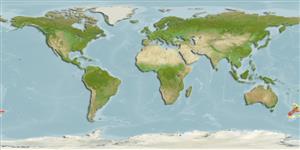Teleostei (teleosts) >
Perciformes/Uranoscopoidei (Sand dwellers) >
Uranoscopidae (Stargazers)
Etymology: Kathetostoma: Greek, kathetos, -on = lime + Greek, stoma = mouth (Ref. 45335); binigrasella: The specific name binigrasella, from the Latin bi for ‘two’, nigra for ‘dark’ and sella for ‘saddle’ refers to the broad dark brown saddle-like bands dorsally on the body that are obvious features distinguishing this species from its New Zealand congener.
Environment: milieu / climate zone / depth range / distribution range
Ecology
Marine; benthopelagic; depth range 10 - 500 m (Ref. 86516), usually 100 - 300 m (Ref. 86516). Temperate
Pacific Ocean: endemic to New Zealand.
Size / Weight / Age
Maturity: Lm ? range ? - ? cm
Max length : 56.0 cm SL male/unsexed; (Ref. 86516)
Short description
Identification keys | Morphology | Morphometrics
Dorsal soft rays (total): 15 - 17; Anal soft rays: 14 - 16; Vertebrae: 30 - 31. Head and body broad, head width 1.2-1.7 times its length, covered with tiny blunt knobs in juveniles to almost smooth in adults; mouth with several prominent canines between smaller canines; chin smooth; ventral margin of preopercle with four spine-like processes; anterior end of isthmus with a pair of prominent forward directed spines; prominent cleithral spine sheathed with skin above pectoral fin base; 17-19 gill rakers on first arch in the form of patches of fine teeth, patches broad, about six to ten teeth across patches, not in distinct rows, innermost teeth rather short; dorsal fin of moderate length, its base 43-66% of predorsal length; pelvic fins large, their length 23-28% SL; body whitish below usually with two broad, vertical, dark-brown, variously distinct bands or saddles across back, most distinct in juveniles and small adults (Ref. 86516).
Found on sand or mud bottoms (Ref. 86516).
Life cycle and mating behavior
Maturity | Reproduction | Spawning | Eggs | Fecundity | Larvae
Gomon, M.F. and C.D. Roberts, 2011. A second New Zealand species of the stargazer genus Kathetostoma (Trachinoidei: Uranoscopidae). Zootaxa 2776:1-12. (Ref. 86516)
IUCN Red List Status (Ref. 130435: Version 2024-2)
Threat to humans
Harmless
Human uses
Tools
Special reports
Download XML
Internet sources
Estimates based on models
Preferred temperature (Ref.
123201): 10.2 - 14.5, mean 13 °C (based on 27 cells).
Phylogenetic diversity index (Ref.
82804): PD
50 = 0.5020 [Uniqueness, from 0.5 = low to 2.0 = high].
Bayesian length-weight: a=0.01000 (0.00244 - 0.04107), b=3.04 (2.81 - 3.27), in cm total length, based on all LWR estimates for this body shape (Ref.
93245).
Trophic level (Ref.
69278): 4.4 ±0.7 se; based on size and trophs of closest relatives
Resilience (Ref.
120179): Low, minimum population doubling time 4.5 - 14 years (Preliminary K or Fecundity.).
Fishing Vulnerability (Ref.
59153): Moderate to high vulnerability (47 of 100).
